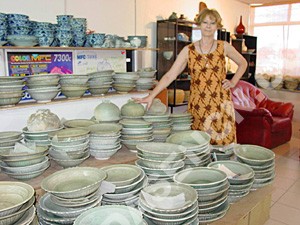Deep water has its secrets, and Roxanna Brown has spent years probing them as a kind of forensic detective of trade patterns in Southeast Asia. Dr. Brown is the director of the Southeast Asian Ceramics Museum on the Rangsit campus of Bangkok University. She is one of the world experts on Chinese and Southeast Asian ceramics. She holds a Ph.D. from UCLA in Art History, and returned to her alma mater October 7 to share what she has learned with faculty and students. Her visit was sponsored by the Center for Southeast Asian Studies.

Roxanna Brown was introduced by UCLA art historian Robert Brown (no relative), who described her as "one of the two or three people who created the field of Southeast Asian ceramics." Roxanna Brown's special interest is the fourteenth, fifteenth, and sixteenth centuries, high points of Asian plate and vase making arts. Already well-known for her 1977 book The Ceramics of South-East Asia, Their Dating and Identification, she described how she became interested in the cargoes of ship wrecks.
For a long time, she said, the principal source of surviving ceramics was archaeological digs at land sites. These were often difficult to date accurately because little of the ceramic ware remained intact and sites were often in use for hundreds of years so that it was hard to pinpoint what kind of ceramics were current at a particular time.
There was a particular question that began to interest specialists as early as the 1950s: whether or not the antiforeign Ming dynasty in China (1368 to 1644) had succeeded in its efforts to curtail Chinese trade with the outside world. The first evidence that this might be the case, Brown said, came in a report by Tom Harrisson, curator of the Sarawak Museum in Borneo, in 1958 noting the absence of Chinese blue and white ceramics at 11 archaeological excavations in Borneo in the 1950s. Harrisson called this omission the "Ming Gap." Harrisson meant the term only as a comparison with the more plentiful Chinese ceramic ware from sites in Brunei at the north end of the same island shared with Borneo. Later studies, Roxanna Brown said, have established that even in Brunei almost all of the samples of Chinese ceramics were produced during the short-lived Hongzhi reign in China (1488-1505), leaving open the question of whether other Ming emperors had successfully clamped down on exports.
At the Manila Trade Pottery Seminar in 1968 archaeologists generally agreed that there was probably a sharp cutback in Chinese exports to Southeast Asia from the 14th to the 16th century, but that this could not be proved because land sites overlapped too much in time and space. "The problem could not be solved by land archaeology," Brown said.
